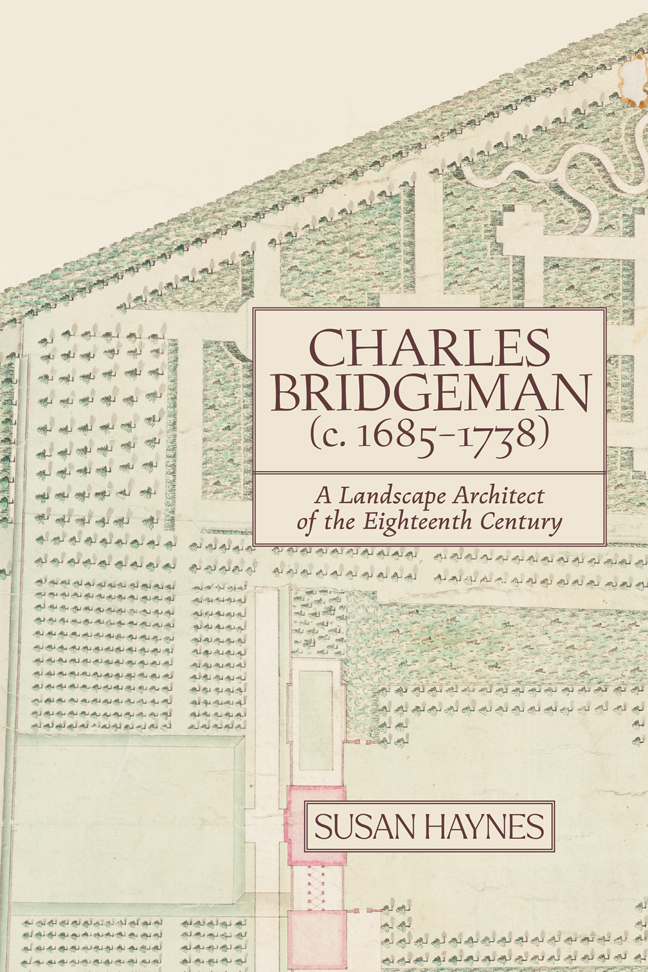Book contents
- Frontmatter
- Dedication
- Maps
- Contents
- List of Illustrations
- Acknowledgements
- List of Abbreviations
- Introduction
- Chapter 1 Who Was Charles Bridgeman?
- Chapter 2 Towards A Reliable Corpus
- Chapter 3 A Revised Catalogue
- Chapter 4 Reading The Plans
- Chapter 5 The Art-Historical Context Revisited
- Chapter 6 The ‘Ingenious Mr Bridgeman’
- Chapter 7 Building a Landscape
- Chapter 8 A Commercial Enterprise
- Conclusion
- Appendix I A summary of Willis's catalogue from Charles Bridgeman and the English Landscape Garden
- Appendix II A revised catalogue
- Appendix III Bridgeman's projects by year
- Appendix IV Bridgeman's income
- Gazetteer of Bridgeman sites
- Glossary
- Bibliography
- Index
- Miscellaneous Endmatter
- Frontmatter
- Dedication
- Maps
- Contents
- List of Illustrations
- Acknowledgements
- List of Abbreviations
- Introduction
- Chapter 1 Who Was Charles Bridgeman?
- Chapter 2 Towards A Reliable Corpus
- Chapter 3 A Revised Catalogue
- Chapter 4 Reading The Plans
- Chapter 5 The Art-Historical Context Revisited
- Chapter 6 The ‘Ingenious Mr Bridgeman’
- Chapter 7 Building a Landscape
- Chapter 8 A Commercial Enterprise
- Conclusion
- Appendix I A summary of Willis's catalogue from Charles Bridgeman and the English Landscape Garden
- Appendix II A revised catalogue
- Appendix III Bridgeman's projects by year
- Appendix IV Bridgeman's income
- Gazetteer of Bridgeman sites
- Glossary
- Bibliography
- Index
- Miscellaneous Endmatter
Summary
CHARLES BRIDGEMAN WAS a landscape architect and gardener of seminal importance. His work for the landed elite of the early eighteenth century, and his role as Royal Gardener, should have ensured him a prominent place in the canon of English landscape gardeners. Yet his name is not well known and only one monograph has been devoted to him and his work. He is regularly reduced to a footnote in garden history discourse. In fact, giving his work the close scrutiny it deserves might change the way we understand the development of garden design in England.
Early in the eighteenth century, Charles Bridgeman began designing vast, austere landscapes. He stripped away all the elaborate ornamentation and formal intricacies of the late seventeenth century and replaced them with simple grass plats, trees in long spare avenues, or in groves sparsely cut through with straight and serpentine walks, water in simple geometric shapes, and, most strikingly, sculpted earth in terraces and amphitheatres of audacious proportions. They changed the shape of the land on a monumental scale in estates from the Home Counties to Yorkshire. Admittedly, most of his landscapes have not survived; a combination of a change in fashion towards the more ‘natural’ landscapes of the later eighteenth century, typified by the work of Lancelot ‘Capability’ Brown, and the ingress of the modern built environment, the housing estates and the golf courses of the twentieth and the twenty-first centuries, has wiped out much of his work. Some landscapes have survived in a degraded form, the bones of the designs visible in crop marks in dry weather, or in digital laser surface mapping (LIDAR). A few have survived intact, and where they have, they are extraordinary in both their imaginative conception and their execution. At Claremont in Surrey, the amphitheatre, cleared of rhododendrons by the National Trust, dominates the landscape. At Lodge Park in Gloucestershire, a vast sweep of sculpted woodland and grass draws the eye to the estate boundary, one kilometre away.
In addition to the ghostly imprints and the few surviving earthworks, we also have other evidence of Bridgeman's works. The most comprehensive is a significant number of plans, the majority of which are held in the Bodleian Library in Oxford, the National Archives in London and the British Library.
- Type
- Chapter
- Information
- Charles Bridgeman (c. 1685-1738)A Landscape Architect of the Eighteenth Century, pp. 1 - 8Publisher: Boydell & BrewerPrint publication year: 2023



